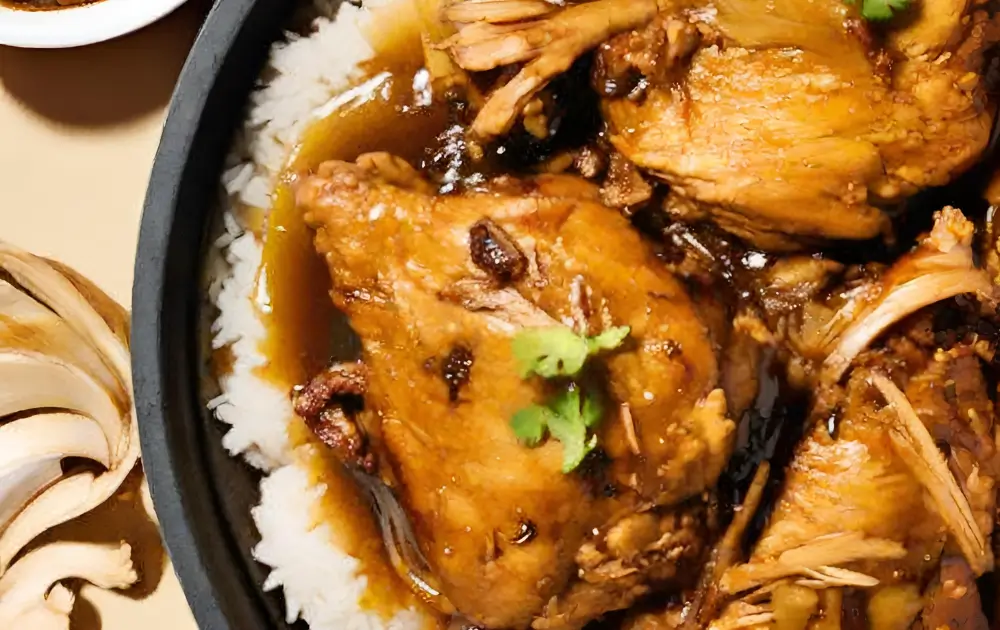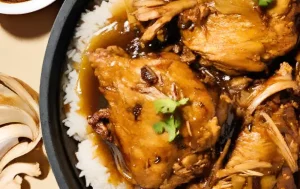In the rich tapestry of Filipino cuisine, one dish stands out for its simplicity, depth of flavor, and cultural significance: Chicken Adobo. This quintessential Filipino dish is a savory blend of vinegar, soy sauce, garlic, and spices, creating a harmonious balance that is both comforting and profoundly satisfying. Chicken Adobo is not just a meal; it’s a reflection of the Filipino spirit, embodying the country’s history, diversity, and its people’s ability to create something beautiful from the simplest ingredients.
The Origins of Adobo
Adobo’s origins can be traced back to the pre-colonial Philippines, where early Filipinos were already practicing the art of marinating and preserving food with vinegar and salt. However, it was the Spanish colonization that introduced the term “adobo,” derived from the Spanish word “adobar,” meaning marinade or pickling sauce. Despite its foreign nomenclature, the method and essence of adobo are purely Filipino, evolving over centuries to become the beloved dish it is today.
The Anatomy of Chicken Adobo
At its core, Chicken Adobo is a study in the power of simplicity. The dish utilizes a marinade or sauce made from soy sauce, vinegar, crushed garlic, bay leaves, and black peppercorns. The chicken is then browned, simmered in this mixture, and allowed to absorb the tangy, savory flavors. The result is tender, flavorful meat that falls off the bone, accompanied by a rich sauce that is perfect over steamed rice.
Regional Variations
While the basic ingredients of Chicken Adobo remain constant, regional variations across the Philippines introduce a delightful diversity to the dish. In some areas, coconut milk is added for a creamier sauce, while others might include pineapple for a touch of sweetness or turmeric for color and earthiness. Each region adds its own signature, making adobo a versatile dish that reflects the local palate and available ingredients.
Chicken Adobo in the Global Kitchen
As Filipinos have traveled and settled around the world, they’ve brought Chicken Adobo with them, sharing this beloved dish with new friends and communities. This has led to further innovation, with variations that include different types of meat, vegetarian versions using mushrooms or tofu, and even fusion dishes that blend Filipino flavors with other culinary traditions. Despite these variations, the essence of Chicken Adobo—its balance of vinegar, soy sauce, and garlic—remains unchanged, a testament to the dish’s enduring appeal.
Cooking Chicken Adobo at Home
One of the joys of Chicken Adobo is its ease of preparation, making it accessible to cooks of all skill levels. The key to a great adobo lies in the balance of soy sauce and vinegar, the quality of ingredients, and patience to allow the chicken to marinate and stew until perfectly tender. With these elements in mind, anyone can create a delicious Chicken Adobo that captures the essence of Filipino cooking.
Chicken Adobo is more than just a dish; it’s a cultural emblem that speaks to the heart of Filipino cuisine and its people. Its simplicity, versatility, and rich flavors have earned it a place at tables around the world, transcending cultural boundaries and bringing people together. Whether enjoyed in a humble Filipino home, a bustling street market, or a fine dining restaurant abroad, Chicken Adobo remains a beloved symbol of Filipino culinary pride, a reminder of home for those far away, and an invitation to explore the rich flavors of the Philippines.
As Chicken Adobo continues to captivate palates globally, its universal appeal lies not only in its taste but also in its ability to adapt and evolve while maintaining its identity. This dish exemplifies the global journey of Filipino cuisine, a journey marked by a fusion of cultures, histories, and flavors that have interacted with the Philippine archipelago over centuries.
A Reflection of Filipino Hospitality
Chicken Adobo, with its hearty and welcoming nature, is a reflection of Filipino hospitality. In the Philippines, sharing a meal is an act of love and community, and Chicken Adobo often takes center stage. Its comforting essence makes it a perfect dish to serve to guests, embodying the warmth and generosity that Filipinos are known for worldwide.
Nutritional Value and Health Aspects
Beyond its cultural and historical significance, Chicken Adobo is appreciated for its nutritional value. Chicken, as the primary ingredient, is a good source of protein. The dish, when prepared with a mindful approach to the amount of soy sauce and oil used, can be a healthy part of a balanced diet. Moreover, the garlic used in the dish is known for its antioxidant properties, and the vinegar may help in digestion.
Adobo: A Symbol of Philippine Resilience
The enduring popularity of Chicken Adobo stands as a testament to Philippine resilience and ingenuity. Through periods of colonization and the myriad influences that have shaped Filipino culture, adobo has remained a constant, a dish that has managed to retain its essence while embracing change. This resilience mirrors the Filipino spirit, characterized by adaptability, creativity, and a profound sense of identity.
Culinary Tips for the Perfect Adobo
For those looking to master Chicken Adobo at home, a few culinary tips can enhance the cooking experience. First, allowing the chicken to marinate for a few hours, if not overnight, will deepen the flavors. Secondly, balancing the soy sauce and vinegar to one’s taste is crucial, as this defines the dish’s signature tangy-savory profile. Lastly, cooking the adobo over low heat and allowing it to simmer slowly will ensure that the chicken is tender and the flavors are well-infused.
The Future of Chicken Adobo
As Filipino cuisine gains more recognition on the global culinary stage, Chicken Adobo stands poised to win over even more hearts and palates. Its basic yet adaptable recipe invites experimentation and innovation, making it relevant in contemporary culinary trends. From traditional family kitchens in the Philippines to trendy international restaurants, Chicken Adobo continues to evolve, symbolizing the dynamic nature of Filipino culture and its cuisine.
Chicken Adobo is more than a dish; it’s a narrative of history, culture, and flavor that resonates well beyond the Philippine shores. It embodies the essence of Filipino cuisine—rich, diverse, and soulful. As it continues to be passed down from generation to generation and shared across the globe, Chicken Adobo remains a culinary treasure, a reminder of the Philippines’ rich cultural tapestry, and a universal symbol of comfort food that transcends boundaries. In every pot of Adobo simmers a story of the Filipino people: their past, their resilience, and their hopeful gaze towards the future.





